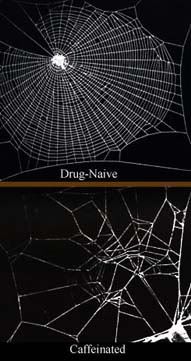
Caffeine: It wakes us up, raises our alertness, and gets us ready for the day. As many as 90% of Americans consume caffeine on a daily basis, either in the form of coffee, tea, soda, or other caffeinated foods. Many people agree that there are few things more enjoyable than a good, hot mug of Joe, but do we really understand what it’s doing in our bodies?
 As much as I like to deny it, caffeine has its downside. Physical side effects include headache, hyperreflexia (muscle twitches), dehydration, irritable bowel syndrome, insomnia, and heart palpitations (not to mention leaching a cold $1.75 out of my pocket every morning...). Its arousing nature may help us wake up in the morning but can also result in physchological side effects like anxiety, irritability, errors of addition, and sketchy work (see the spider web at left). How can just one little molecule have so many physiological and even psychological effects? Well, this may be because it of what it mimics more than what it is...
As much as I like to deny it, caffeine has its downside. Physical side effects include headache, hyperreflexia (muscle twitches), dehydration, irritable bowel syndrome, insomnia, and heart palpitations (not to mention leaching a cold $1.75 out of my pocket every morning...). Its arousing nature may help us wake up in the morning but can also result in physchological side effects like anxiety, irritability, errors of addition, and sketchy work (see the spider web at left). How can just one little molecule have so many physiological and even psychological effects? Well, this may be because it of what it mimics more than what it is...Caffeine is the common name for 1,3,7-trimethylxanthine, an analog of adenosine (a nucleotide). Here they are, side by side to show their likeness:

To understand caffeine you must first understand this very active, biochemically relevant molecule.
Adenosine plays important roles in many biochemical processes. Intravenous adenosine can affect whole tissues and is partially responsible for regulation of the AV node in the heart, which conducts electrical impulses from the atria to the ventricles. Caffeine’s mimicry of this molecule may act on that same tissue, leading to heart palpitations with excessive consumption. Adenosine is also known to causes relaxation of smooth muscle such as that found inside the artery walls and intestine. The loose bowels people can get from caffeine consumption are likely due to its mimicry of adenosine on the intestines, while the headache withdrawals are a result of pinching of the blood vessels that are used to caffeine driven dilation.
In the brain, caffeine acts as an antagonist to adenosine receptors. Caffeine binds to the adenosine receptors without activating them, decreasing their function. Since adenosine receptors are often inhibitory in nature, this may explain some of caffeine’s excitatory effects. Caffeine is also theorized to excite dopamine receptors and acetylcholine receptors, the neurotransmitters associated with reward and musculature activity respectively. Research is still underway to validate this theory though.
Even the metabolites of caffeine are active biochemically. Caffeine is metabolized in the liver leading to the creation of other metabolites, the three most common being:
Paraxanthine (1,7-dimethylxanthine, 84%)– This molecule may increase lipolysis, leading to elevated glycerol and free fatty acid levels in the blood stream.
Theobromine (3, 7-dimethylxanthine, 12%)– This molecule is also found in chocolate, accounting for some of its caffeine-like qualities. Theobromine dilates blood vessels and acts a diuretic.
Theophylline (1,3-dimethyl-7H-purine-2,6-dione, 4%)– Is a molecule used to treat asthma due to its effectiveness in relaxing the smooth muscles of the bronchi. The amount gained from caffeine consumption is not enough to induce these therapeutic effects though.
Heart problems and bowel movements are not usually what one associates with caffeine though. What about its ability wake us up in the morning? To explain this one, we may have to delve deeply into one of adenosine’s primary functions as a signal transduction molecule in the glycogen degradation pathway. Caffeine is exceptionally good at interfering with this role of adenosine.
Glycogen is found in granules in the liver and muscles. It is, basically, large balls of glucose (sugar) waiting to be degraded to supply your brain and body with energy when your blood sugar is low. Glucagon and epinephrine (also called adrenaline) are hormones produced when the body needs energy fast. They signal cells to begin the breakdown of glycogen by the enzyme glycogen phosphorylase. In contrast, insulin is produced when blood sugar is high and signals cells to begin synthesis of glycogen by the enzyme glycogen synthase. Adenosine in the form of cyclic adenosine monophosphate (cAMP) is an important part of this process as it continues the signal transduction cascade initiated by epinephrine or glucagon. Below is a basic scheme of how epinephrine (adrenaline) or glucagon signaling leads to cAMP production. The details are not as important, but just realize that cAMP is our product:

An increase in cAMP in the cell lets the glycogen degrading enzyme, glycogen phosphorylase, know it’s time to pick up the pace while at the same time signaling glycogen synthase to step off and stop making glycogen. The overall effect is release of glucose for energy. As cAMP is being created in abundance by the action of epinephrine or glucagon, it is also actively being degraded by the enzyme phosphodiesterase into AMP to ensure it does not get out of control. Caffeine acts as an inhibitor to the enzyme phosphodiesterase. With phosphodiesterase distracted, cAMP builds up in the cell keeping glycogen phosphorylase working at full throttle, therefore giving your brain and body an extra glucose boost.
It is clear that the effects of caffeine on the body are far reaching and they're not all good. Should this be cause for alarm? Nah, I know my coffee habit isn’t kicking anytime soon. Just be careful and listen carefully to your body well, be wary of signs that you've been drinking too much (like irritability, insomnia, twitching, headache). In the mean time, enjoy your java!

Sources:
There are a lot of contradictory articles out there on the biological impact of caffeine. I primarily relied upon the web site http://www.cosic.org/ for the first half of the article, while all information on caffeine’s role in the glycogen degradation pathway comes straight from my biochemistry course taught by Dr. Douglas Cole.
Most of the pictures, as usual, come from wikipedia


5 Comments:
Thank you Kim. Amazing.
By Anonymous, at 8:07 PM
Anonymous, at 8:07 PM
Good to know what my addiction is doing in my body :D
And thanks to Anatomy, I actually understood about half of your techno-babble! Go me!
By Anonymous, at 10:56 PM
Anonymous, at 10:56 PM
Got to love that little chemical. Nice write up.
By Anonymous, at 2:36 PM
Anonymous, at 2:36 PM
There are blogs filled with poetry about how the darkness of life's woes casts shadows over the river Styx or the latest drama in a group of five teenage white girls... Then there's this: a blog I actually want to read.
Keep it up!
By Anonymous, at 2:27 AM
Anonymous, at 2:27 AM
So now I'm thinking about the long-term affects caffeine could have on weight...
By Anonymous, at 7:21 PM
Anonymous, at 7:21 PM
Post a Comment
<< Home